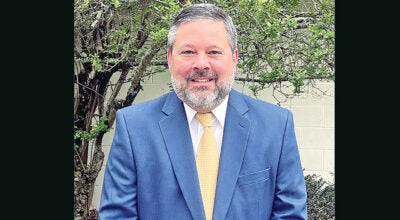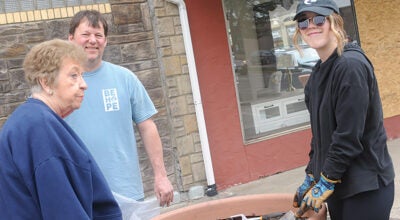Earlier Black Friday kicks off shopping season
Published 9:41 am Friday, November 23, 2012
(AP) — This year’s Black Friday shoppers were split into two distinct groups: those who wanted to fall into a turkey-induced slumber and those who’d rather shop instead.
Stores typically open in the wee hours of the morning on the day after Thanksgiving that’s named Black Friday because it’s traditionally when retailers turn a profit for the year. But after testing how shoppers would respond to earlier hours last year, stores such as Target and Toys R Us this year opened as early as Thanksgiving evening. That led shoppers on a mission to find the best Black Friday deals to ask a difficult question: Deal with the crowds now or later?
Crystal Camacho, 19, and Sammy Caban, 23, got to Best Buy in the Manhattan borough of New York City at 12:30 a.m. on Black Friday with one goal in mind, a 40-inch Toshiba TV on sale for $180. They were determined, even though they both worked on Thanksgiving Day and had to work on Black Friday, she as a restaurant hostess and he as salesperson at GameStop. Five hours later, a little after 5 a.m., they walked out with the TV.
“It was crazy but well worth it,” Caban said. “We got lucky.”
Elizabeth Garcia, a sales rep from the city’s Bronx borough, decided for a later shopping started at about 3:30 a.m. at a nearby Toys R Us in New York’s Times Square. Garcia, who has three children ages three, five and seven, said she specifically decided on the later time to avoid the crowds on Thanksgiving when the store opened at 8 p.m. She believes that was the best decision: Last year, Garcia almost got into a fight over a Tinker Bell couch, but this year things were much calmer.
“This year I wasn’t about to kill people,” she said.
It is unclear how many shoppers were drawn to the earlier openings versus the traditional Black Friday hours. But according to an International Council of Shopping Centers-Goldman Sachs survey of 1,000 consumers conducted this month, about 17 percent planned to shop at stores that opened on Thanksgiving, up from 16 percent last year when retailers were testing the earlier hours. Meanwhile, 33 percent intended to shop on Black Friday, down one percentage point from last year. Overall, it’s estimated that sales on Black Friday will be up 3.8 percent to $11.4 billion this year.
The earlier hours are an effort by stores to make shopping as convenient as possible for Americans, who they fear won’t spend freely during the two-month holiday season in November and December because of economic uncertainty. Many shoppers are worried about high unemployment and a package of tax increases and spending cuts known as the “fiscal cliff” that will take effect in January unless Congress passes a budget deal by then. At the same time, Americans have grown more comfortable shopping on websites that offer cheap prices and the convenience of being able to buy something from smartphones, laptops and tablet computers from just about anywhere.
That’s put added pressure on brick-and-mortar stores, which can make up to 40 percent of their annual revenue during the holiday shopping season, to give consumers a compelling reason to leave their homes. That’s becoming more difficult: the National Retail Federation, an industry trade group, estimates that overall sales in November and December will rise 4.1 percent this year to $586.1 billion, or about flat with last year’s growth. But the online part of that is expected to rise 15 percent to $68.4 billion, according to Forrester Research.
As a result, brick-and-mortar retailers have been trying everything they can to lure consumers into stores. Some stores tested the earlier hours last year, but this year more retailers opened their doors late on Thanksgiving or at midnight on Black Friday. In addition to expanding their hours, many also are offering free layaways and shipping, matching the cheaper prices of online rivals and updating their mobile shopping apps with more information.
“Every retailer wants to beat everyone else,” said C. Britt Beemer, chairman of America’s Research Group, a research firm based in Charleston, S.C. “Shoppers love it.”
Indeed, some holiday shoppers seemed to find stores’ earlier hours appealing. About 11,000 shoppers were in lines wrapped around Macy’s flagship store in New York City’s Herald Square when it opened at midnight on Black Friday. Joan Riedewald, a private aide for the elderly, and her four children ages six to 18, where among them. By the time they showed up at the department store, Riedewalde had already spent about $100 at Toys R Us, which opened at 8 p.m., and planned to spend another $500 at Macy’s before heading to Old Navy.
“I only shop for sales,” she said.
Carey Maguire, 33, and her sister Caitlyn Maguire, 21, showed up at the same Target about two hours before it opened. Their goal was to buy several Nook tablet computers, which were on sale for $49. But while waiting in line they were also using their iPhone to do some online buying at rival stores.
“If you’re going to spend, I want to make it worth it,” said Caitlyn Maguire, a college student.
By the afternoon on Thanksgiving, there were 11 shoppers in a four-tent encampment outside a Best Buy store near Ann Arbor, Mich., that opened at midnight. The purpose of their wait? A $179 40-inch Toshiba LCD television is worth missing Thanksgiving dinner at home.
Jackie Berg, 26, of Ann Arbor, arrived first with her stepson and a friend Wednesday afternoon, seeking three of the televisions. The deal makes the TVs $240 less than their normal price, so Berg says that she’ll save more than $700.
“We’ll miss the actual being there with family, but we’ll have the rest of the weekend for that,” she said.





